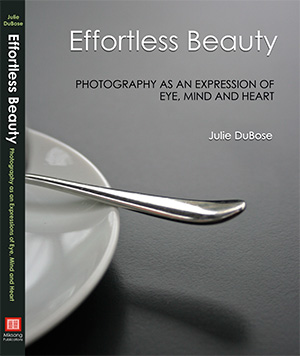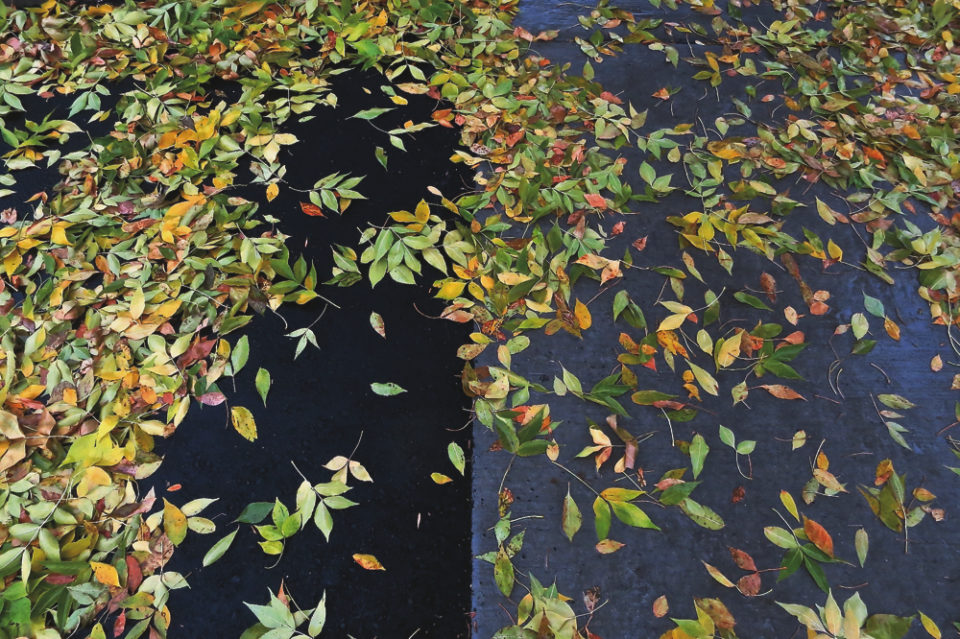Last year I posted extensively about my experiences with the book, The Practice of Contemplative Photography(paid link), by Michael Wood and Andy Karr. Afterwards, I attended a workshop in Boulder, Colorado led by Michael Wood and his partner, Julie DuBose. The experience was one of the best I’ve ever had – a combination of excellent teaching, the magic of Boulder, and the incredible like-minded group they had gathered from all over the world.
 Now, Julie DuBose has published her book, Effortless Beauty: Photography as an Expression of Eye, Mind and Heart. And, a beautiful book it is.
Now, Julie DuBose has published her book, Effortless Beauty: Photography as an Expression of Eye, Mind and Heart. And, a beautiful book it is.
In person, Julie has an inner stillness which is palpable and this quality shines through her images and writing.
Her book delves into how to prepare the mind, heart, and body for the experience of fresh perception. And, how the practice of deep seeing can have a profound impact on how we live and appreciate our lives.
The Introduction describes why contemplative photography is an important practice – it helps us see our world anew every day.
What if we could look at our partners and see them completely and deeply, would we be able to love them more fully? If we could look at snow falling on the pavement and feel its gentles softness on our face, would we simply enjoy the experience without our habitual dread of cold, snowy days? Could we discover the brilliant colours in our world and simply enjoy? We could live this way.
Preparing the Mind
Julie begins by explaining how we are born taking in the world through all of our senses. As we grow, we make sense of our world through naming, judging and filtering. Preparing the mind for contemplative photography is a continual process of letting go of our preconceptions.
If we begin with an open, receptive, curious, attentive mind, free of judgment and the desire to interpret, the impulse to express will flow through us, vibrating with possibility. From this openness, unconditional expression is born.
Experiencing Perceptions
When we are truly present and our minds are ready, perceptive possibilities are everywhere. They are experienced, according to Julie, like flashes of lightning. Our mind is stopped and “what we see is vivid, brilliant, and rich.”
The next step is to stay with the perception and understand what it is – colour, line, light, texture, or a combination? Where does the perception begin and end? Is it vertical or horizontal? Only by understanding the perception will we be able to express it as we experienced it.
As photographers, our tendency at this point is to try and improve on the perception or to alter it in some way. We become focused on the final outcome and whether others will find it interesting or beautiful. This is a real obstacle to direct seeing.
It is not unusual for us to doubt the value of our experience, unless it has been confirmed and validated by others. We are also taught that unless something has significance it isn’t worthy of notice. Imputed meaning is completely relative – it is always changing and being reinterpreted according to changing views. We need to develop trust in our experience. Then we can produce a photograph that expresses the depth and dimensionality of our experience.
The Image as Completion
If contemplative photography is a practice of direct seeing, why take the photograph? Julie’s answer really resonates with me.
Perhaps because we have a deep need to share our experience. The photograph becomes a living expression of our experience. Because our relationship with this perception is so full-bodied, because we have connected with our mind and our heart, we can come back to the image of this perception again and again and experience the freshness of that first moment. We have honoured our experience of perception fully.
A New Way of Living
By practicing this direct seeing and photographing, we are able to develop a stance of true appreciation for our lives.
Contemplative photography is a shift in awareness from looking for the highlights in our visual world to a state of deep noticing. We feel the joy of deep, unconditional relationship. The more we develop our ability to rest in stillness, relax our point of view, and really see and connect with our world, the more fully we will live our lives every day.
For those interested in truly understanding perception from the Miksang point of view, I highly recommend this book. Tomorrow, I will post Julie’s answers to a few questions I posed after reading the book.
Learn more about Effortless Beauty.

I just bought the e-book and it’s wonderful! I look forward to reading your interview with Julie.
The excerpts you have shared here from Julie’s book are so much in harmony with what I like to express through photography. Thank you for sharing all these insights, Kim. I look forward to your next posting!
Kim, I just came back to say how I enjoyed listening to Julie’s long interview that I’ve just finished listening to! I will listen to it again to pick up the details I may have missed the first time around. I love it when she says: “to see one thing at a time in the moment.” What a lovely lady!